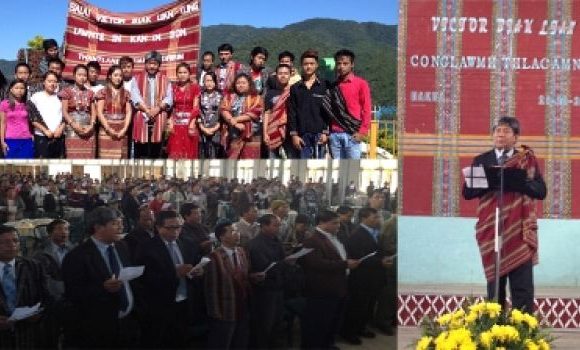The crux of Conflict : Ethno-centric Burman superiority mindset
Most commentators, especially those of Burman origin explain the ethnic conflict in Burma by condeming the colonial rulers as a scapegoats of Burma’s prolonged political deadlock. They said the internal hostilities and conflict of Burma was a legacy of Colonial rule. On the other hand, some Burman chauvinists said the secession rights for the Shan and Karreni peoples, which can be exercised after 10 years of living in the Union, clearly spelled out in the written Constitution of 1947 was a problem.
By all means, if one fully understands the nature of the twist and turns of real politics, they would rather come to conclude that neither the conflict of present Burma is that of the legacy of colonial rule nor is the secession rights entailed in the Union Constitution. But rather, to cut it short, the conflict staggering the Union of Burma is the chauvinistic mindset and Burman superior ethno-centrism possessed by the ethnic Burman, thinking that majority Burman ethnic groups are superior to the rest of other nationalities was the chief reason and it has been the crux of the Burma’s internal conflict. To make it clear, the tyranny of Burman majority and (their) the Burman ethnic groups’ blatant refusal to accept the equal status of the rest of the ethnic nationalities as equal partners of the Union dragged Burma into a conflict zone. To clarify the over-mentioned statement, unlike our fellow ethnic Burmans, we should understand that the colonial rulers had fully recognized the national sovereignty, self-determination, and legitimate independence of the Chin, Kachin, and Shan nations.
A native Shan scholar, late Dr. Choa Tzang Yawnghwe, the son of first president of newly independent Burma, stated, “The ethnic dimension of state-society dysfunction in Burma has two interrelated facets. One is political, and the other has to do with the restoration of ethnic harmony”. Not only ethnicity, to reinforce it, the main problem and the existent nature of conflict in the Union of Burma is political as it was widely agreed by most scholars and analysts. In the case of Burma, given the fact that Burma is multi-ethnic country, race or ethnicity plays a key role in shaping the Union of Burma. Again in 1960-62, when the non-Burman leaders collectively attempted to readdress the Constitutional crises based on federal system as envisioned in the Panglong conference, U Ne Win, the first dictator of Burmese military regime, who misunderstood the term federalism or federalist movement of ethnic leaders as a secession from the Union, staged a military coup with the pretext of saving the Union from breaking up. Here, either Ne Win or any one possessing the same ideology of such kind should have understood that the quetion of leaving the Union or joining the Union was totally upto each region joining the Union on equal footing and voluntary basis.
To make it clear here, even though Ne Win had justified his military coup with a beautiful phrase, “rescuing the Union from disintegration”, the chief reason behind his action was driven by the fact that his chauvinistic view of Burman being a superior ethnic groups or big brothers to the rest of other nationalities, and that very notion motivated him to deny the inherent and constitutional rights of the ethnic Shan, Karenni, Kachin, Chin and other nationalities. Actually, to bring historical fact, during the struggle for independence from the British, the demand of the amalgamation of the excluded areas such as the Chin, Kachin, Shan, and Karenni into the political dominion of Burma proper by leaders of ministerial Burma or Burma proper was the attempt of Burman chauvinists to assimilate those culturally diverse ethnic nationalities into Burmanization. However, the British imperialists made it clear to U Aung San and his delegates visiting London for Burma’s independence that no independence of the entire present day Union of Burma could be handed over unless and without the prior consultation and authorized approval of those excluded areas or frontier peoples and, furthermore stated that the ultimate decision for the future of those excluded areas had to be only made by they themselves alone. After realizing the absulute necessity of realizing the equal status of those independent nations with ministerial Burma, U Aung San returned to consult the leaders of these independent nations that he had no right whatsoever to represent in the up-coming London talk. In the conference that was held in February 1947 after he came back from London, U Aung San had fully acknowledged the national sovereignty of Chin, Kachin, Shan and Karreni. We have to understand the fact that Burmanization had long been started since the independence movement.
From the time the Union of Burma became independent in 1948 until today, regardless of the parliamentary democracy era under Prime Minister U Nu, the revolutionary Council later known as the Burmese Socialist Program Party (BSPP) under dictator or tyrant Ne Win, the State Law and Order Restoration Council (SLORC) under General Saw Mawng, and currently the State Peace and Development Council (SPDC) under General Than Shwe, the names and their banners only has changed, but they are all of the same ethnicity, belonged to the race of Burman or Myanmarese ethnic group. Their underlying philosophy behind their grip on power is driven by the same ideology. Their view is to hold up Burmese as a superior one and maintain that the Burmans should control the Union by exploiting the rest of the other nationalities. Their move is to be interpreted as a force to assimilate all the diverse ethnic groups into Burmanization.
While defining this notion of Burman being a superior race, Dr. Choa Tzang eloquently pointed out that,” It is important for all the races, especially for the Bama, to fully embrace the idea of equality. Many Bama seem to think of the Bama as superior, or as “Big Brothers”, although there is no evidence of the Bama being superior to any “race”, collectively or individually”. For the peaceful co-existence of those culturally diverse nationalities within one political system is concerned, unless the Burman ethnic groups discard the superior ideology of their nationalism, no stable Union can be established. Therefore, regardless of what ethnic group one belongs to, at the first place, all the stakeholders should eliminate the notion of attempting to control the collectively owned territory of the Union of Burma by a single ethnic group. By excluding the rest of the other ethnic groups, no single ethnic group has right to determine and discuss the future interest of the Union on any issues that are related to the well-defined territory of the Union of Burma. All ethnic groups in the Union claim their own inherent national rights both individually and collectively and not of the rights that does not belong to them.
Historically, despite the exploitation of all sorts of political cleavages were played against the non-Burman ethnic nationalities by the Burman majority groups with their driven ethno-centrism, the non-Burman ethnic nationalities are committed to building a stable union under the federalism. As the term “Federal Union” is a Union formed jointly by diverse independent people, while still retaining their national identities, for the future reformation of the Union of Burma, any move to oppose federal state or federal union by proposing a unitary state is a roadblock to achieving the stable Union. Ever since the 1988 people’s uprising, all the ethnic nationalities of the Union of Burma have jointly participated in the struggle for democracy together with ethnic Burmese which would respect the principle of equality, national self-determination, and political autonomy for every nationalities within the Union.
Regardless of any ideological confrontation towards rebuilding the stable Union, the key to solving the conflicts of the Union of Burma is to have the unanimous acceptance and recognition of each national sovereignty and equal status respectively by all ethnic nationalities of the Union. No superiority or inferiority whatsoever among the stakeholders of the Union. At this point, what we have to make clear is the term the usage of ethnic minorities in referring to the collective forces of the non-Burman ethnic segments such as the Chin, Kachin, Mon, Rakhine (Arakan), Karenni. They are neither ethnic minorities nor indigenous peoples; they are peoples and nation with rich culture, living in the well-defined territory of their own and they have a history like those of our fellow Burmans. To repeat, they occupied their well-defined demarcation of their own territory like their fellow Burmans. Let us be very clear that there is no predestined provision or any sort of authorization provided to the Burman ethnic groups to exploit against the rest of other nationalities in today’s political arena of the Union of Burma. Therefore, to establish a stable Union in future, the onus totally is on our fellow Burman. They should sincerely mull over whether they would discard their superiority mindset or they would continuously repeat the colossal mistakes that they commited behind the long political deadlocks of the Union of Burma which our entire history seem to witness never unendingly.
(Commentator, Salai Za Ceu Lian, a student at the University of Winnipeg, Manitoba, is currently Secretary of Burmese Community Organization of Manitoba. He is also in-charge of Alliance Affairs for the Chin National League for Democracy (Exile), a political party which won 3 Parliamentary seats in Chin State during the 1990 general elections in Burma. He was a former Chin Youth representative at the United Nationalities Youth League (UNYL), multi-ethnic youth alliance based in Thailand, and was a former Assistant General Secretary of the Committee for Non-violent Action for Burma (CNAB) based in India. He also works as Associate Editor for Chinland Guardian and Rhododendron News, a bi-monthly human rights newsletter published by Chin Human Rights Organization)
Chinland Guardian
By Salai Za Ceu Lian
Date: 20th April, 2005




